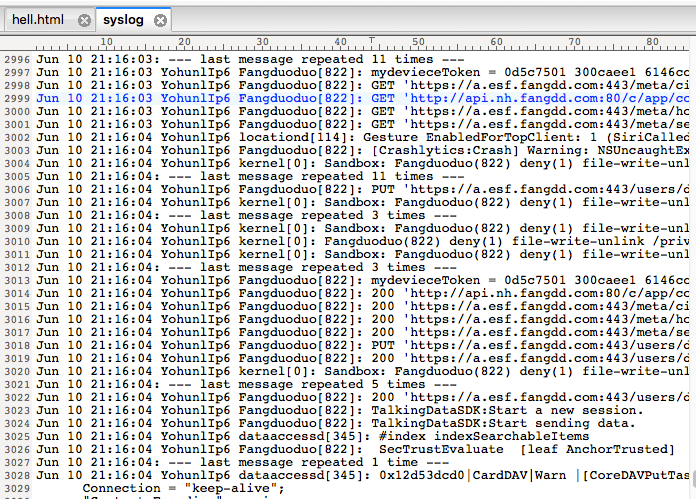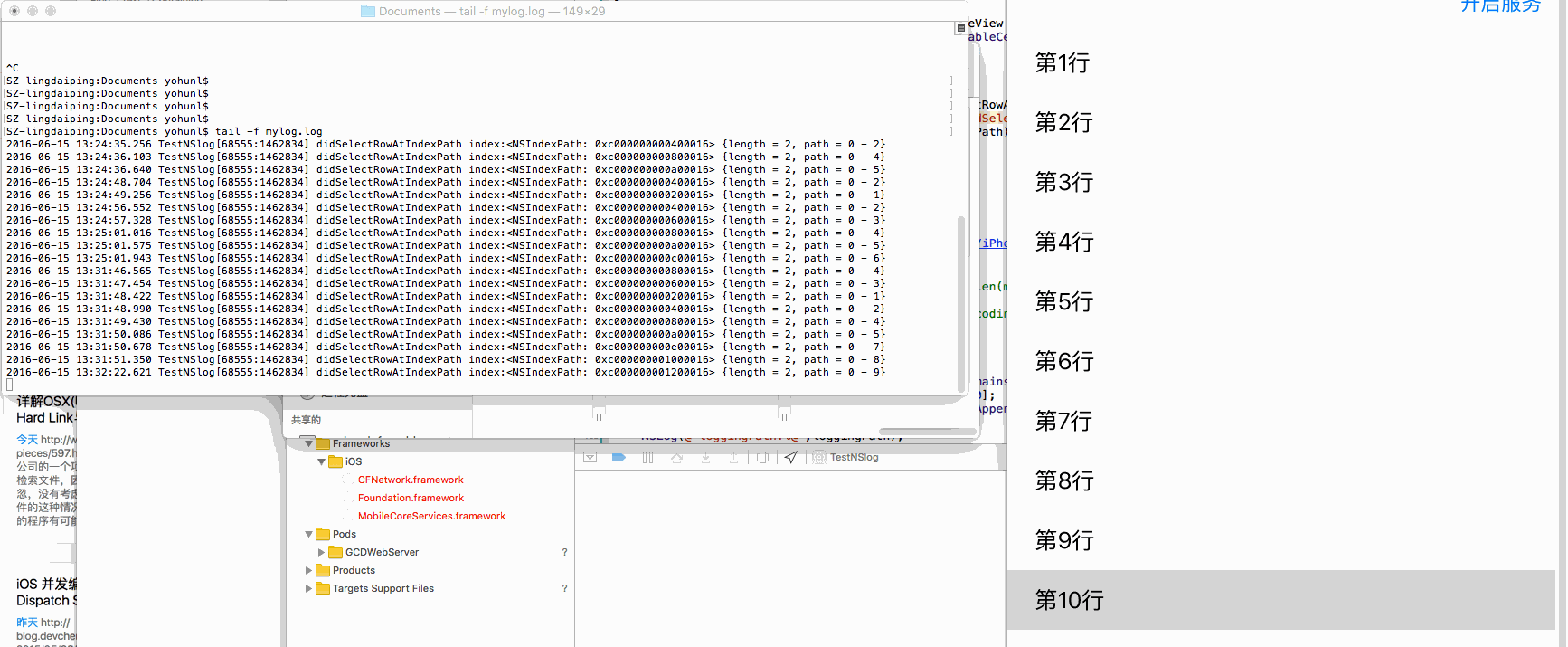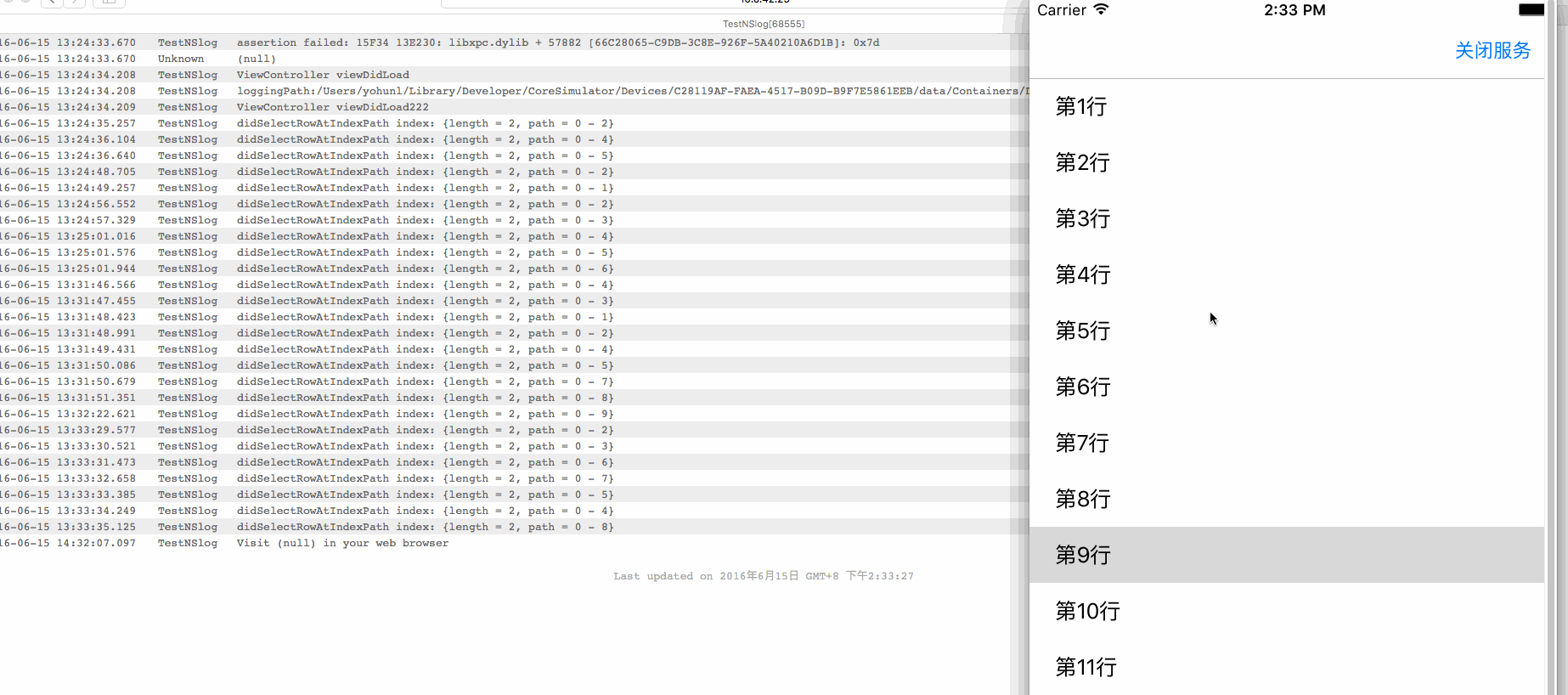平时我们写代码的时候,为了调试方便,总是会在代码中写入很多的NSLog(也可能是其它的日志框架等,例如大名鼎鼎的CocoaLumberjack),但是我们对于NSLog到底了解多少?NSLog的信息为什么Xcode能够获取的到?我们能自己写个程序获取所有的NSlog么?NSLog写入的信息到底在哪里?
NSLog输出到哪?
我们都知道,NSLog是一个C函数,它的函数声明是
void NSLog(NSString *format, ...)
系统对其说明是:Logs an error message to the Apple System Log facility.,它是用来输出信息到标准的Error控制台上去.其内部其实是使用Apple System Log(ASL:苹果自己实现的输出日志的一套接口)的API.在iOS真机设备上,使用ASL记录的log被缓存在一个文件中,直到设备被重启.
这里提到的ASL,都是放在ash.h这个头文件中,这套api可以获取指定的日志数据.具体可以参考ASL参考
从上面可以直到,NSLog默认被系统输出到了一个文件中,这个文件是哪个呢?NSLog默认的输出到了系统的 /var/log/syslog这个文件中,当然了,如果你的机器没有越狱,你是查看不了这个文件的.我手机是越狱的,于是乎验证了下,使用iTools等工具将真机的/var/log/syslog文件导出,下面就是这个文件的部分内容的截取
 从中,我们可以看到,所有的APP的NSLog全部都是写到这个文件中的!!!
从中,我们可以看到,所有的APP的NSLog全部都是写到这个文件中的!!!
标准的err控制台
我们现在了解到了NSLog就是输出到文件syslog中,既然要往文件中写,那么肯定就有文件的句柄了,这个文件的句柄是多少呢? 在C语言中,我们有三个默认的句柄
#define stdin __stdinp
#define stdout __stdoutp
#define stderr __stderrp
其对应的iOS系统层面的上述三个句柄其实也就是下面的三个
#define STDIN_FILENO 0 /* standard input file descriptor */
#define STDOUT_FILENO 1 /* standard output file descriptor */
#define STDERR_FILENO 2 /* standard error file descriptor */
我们的NSLog输出的是到 STDERR_FILENO 上,我们可以使用c语言的输出到文件的fprintf来验证一下
NSLog(@"ViewController viewDidLoad");
fprintf (stderr, "%s\n", "ViewController viewDidLoad222");
在Xcode的控制台可以看到输出
2016-06-15 12:57:17.286 TestNSlog[68073:1441419] ViewController viewDidLoad
ViewController viewDidLoad222
由于fprintf并不会像NSLog那样,在内部调用ASL接口,所以只是单纯的输出信息,并没有添加日期,进程名,进程id等,也不会自动换行.
NSLog的重定向
既然NSLog是写到STDERR_FILENO中去的,那么根据Unix的知识,我们可以重定向这个文件,让NSLog直接写到文件中去
//to log to document directory
NSArray *paths = NSSearchPathForDirectoriesInDomains(NSDocumentDirectory, NSUserDomainMask, YES);
NSString *documentsPath = [paths objectAtIndex:0];
NSString *loggingPath = [documentsPath stringByAppendingPathComponent:@"/mylog.log"];
//redirect NSLog
freopen([loggingPath cStringUsingEncoding:NSASCIIStringEncoding], "a+", stderr);
利用c语言的freopen函数,进行重定向,将写往stderr的内容重定向到我们制定的文件中去,一旦执行了上述代码,那么在这个之后的NSLog将不会在控制台显示了,会直接输出在文件mylog.log中!
在模拟器中,我们可以使用终端的tail命令(tail -f mylog.log)对这个文件进行实时查看,就如同我们在xcode的输出窗口中看到的那样,你还可以结合grep命令进行实时过滤查看,非常方便在大量的日志信息中迅速定位到我们要的日志信息

在真机中,这种重定向有什么用处呢? 由于重定向到的文件是我们沙盒中的文件,那么就可以在我们的程序中写一段代码将这个文件发送给我们,远程的用户app出了问题,把日志发送给我们,我们就可以根据日志信息,找寻可能的问题所在!
也可以开启app的文件夹itunse共享
配置共享文件夹:
在应用程序的Info.plist文件中添加UIFileSharingEnabled键,并将键值设置为YES。将您希望共享的文件放在应用程序的Documents目录。一旦设备插入到用户计算机,iTunes 9.1就会在选中设备的Apps标签中显示一个File Sharing区域。此后,用户就可以向该目录添加文件或者将文件移动到桌面计算机中
就是说,一旦设备连接上电脑,可以通过iTune查看指定应用程序的共享文件夹,将文件拷贝到你的电脑上看
一般我们都会在应用中放置一个开关,开启或者关闭Log日志的重定向,在上面,我们使用标准C的freopen将stderr重定向到我们的文件中了,那么问题来了,怎么重定向回去呢???
FILE * freopen ( const char * filename, const char * mode, FILE * stream );
要想重定向回去,那么我们需要知道stderr原来的文件路径,很遗憾,这个在不同平台中是不一样的,在iOS平台,由于沙盒机制,我们也并不能直接使用沙盒外的文件 对此,freopen将无能为力,要重定向回去,只能使用Unix的方法dup和dup2!
//在ios上可用的方式,还是得借助dup和dup2
int originH1 = dup(STDERR_FILENO);
FILE * myFile = freopen([loggingPath cStringUsingEncoding:NSASCIIStringEncoding], "a+", stderr);//这句话已经重定向了,现在NSLog都输出到文件中去了,
//……………….
//恢复原来的
dup2(originH1, STDERR_FILENO);//就可以了
其它重定向STDERR_FILENO的方式集锦
方式一 采用dup2的重定向方式
(选自lizaochengwen.iteye.com/blog/147608…)
- (void)redirectSTD:(int )fd{
NSPipe * pipe = [NSPipe pipe] ;
NSFileHandle *pipeReadHandle = [pipe fileHandleForReading] ;
int pipeFileHandle = [[pipe fileHandleForWriting] fileDescriptor];
dup2(pipeFileHandle, fd) ;
[[NSNotificationCenter defaultCenter] addObserver:self
selector:@selector(redirectNotificationHandle:)
name:NSFileHandleReadCompletionNotification
object:pipeReadHandle] ;
[pipeReadHandle readInBackgroundAndNotify];
}
- (void)redirectNotificationHandle:(NSNotification *)nf{
NSData *data = [[nf userInfo] objectForKey:NSFileHandleNotificationDataItem];
NSString *str = [[NSString alloc] initWithData:data encoding:NSUTF8StringEncoding] ;
//这里可以做我们需要的操作,例如将nslog显示到一个textview中,或者是存放到另一个文件中等等
//self.logTextView.text = [NSString stringWithFormat:@"%@\n%@",self.logTextView.text, str];
NSRange range;
//range.location = [self.logTextView.text length] - 1;
range.length = 0;
//[self.logTextView scrollRangeToVisible:range];
[[nf object] readInBackgroundAndNotify];
}
使用的时候
[self redirectSTD:STDERR_FILENO];
就可以将NSLOg的输出重定向到我们的通知中去!!!
方式二 使用GCD的dispatch Source
- (dispatch_source_t)_startCapturingWritingToFD:(int)fd {
int fildes[2];
pipe(fildes); // [0] is read end of pipe while [1] is write end
dup2(fildes[1], fd); // Duplicate write end of pipe "onto" fd (this closes fd)
close(fildes[1]); // Close original write end of pipe
fd = fildes[0]; // We can now monitor the read end of the pipe
char* buffer = malloc(1024);
NSMutableData* data = [[NSMutableData alloc] init];
fcntl(fd, F_SETFL, O_NONBLOCK);
dispatch_source_t source = dispatch_source_create(DISPATCH_SOURCE_TYPE_READ, fd, 0, dispatch_get_global_queue(DISPATCH_QUEUE_PRIORITY_HIGH, 0));
dispatch_source_set_cancel_handler(source, ^{
free(buffer);
});
dispatch_source_set_event_handler(source, ^{
@autoreleasepool {
while (1) {
ssize_t size = read(fd, buffer, 1024);
if (size <= 0)="" {="" break;="" }="" [data="" appendbytes:buffer="" length:size];="" if="" (size="" <="" 1024)="" nsstring="" *astring="[[NSString" alloc]="" initwithdata:data="" encoding:nsutf8stringencoding];="" printf("astring="%s",[aString" utf8string]);="" nslog(@"astring="%@",aString);" 读到了日志,可以进行我们需要的各种操作了="" });="" dispatch_resume(source);="" return="" source;="" code="">使用的时候
_sourt_t = [self _startCapturingWritingToFD:STDERR_FILENO];
记得,要自己保留返回的dispatchsourcet对象,不然其释放了,你就获取不到了!
ASL读取日志
以上的方式,都是重定向文件,一旦重定向后,那么NSLog就不会再写到系统的syslog中去了,也就意味着不能使用ASL接口获取到重定向后的数据了.
不重定向NSLog,怎么读取所有的log呢?
ASL读取log的核心代码
+ (NSMutableArray *)allLogMessagesForCurrentProcess
{
asl_object_t query = asl_new(ASL_TYPE_QUERY);
// Filter for messages from the current process. Note that this appears to happen by default on device, but is required in the simulator.
NSString *pidString = [NSString stringWithFormat:@"%d", [[NSProcessInfo processInfo] processIdentifier]];
asl_set_query(query, ASL_KEY_PID, [pidString UTF8String], ASL_QUERY_OP_EQUAL);
aslresponse response = asl_search(NULL, query);
aslmsg aslMessage = NULL;
NSMutableArray *logMessages = [NSMutableArray array];
while ((aslMessage = asl_next(response))) {
[logMessages addObject:[SystemLogMessage logMessageFromASLMessage:aslMessage]];
}
asl_release(response);
return logMessages;
}
//这个是怎么从日志的对象aslmsg中获取我们需要的数据
+(instancetype)logMessageFromASLMessage:(aslmsg)aslMessage
{
SystemLogMessage *logMessage = [[SystemLogMessage alloc] init];
const char *timestamp = asl_get(aslMessage, ASL_KEY_TIME);
if (timestamp) {
NSTimeInterval timeInterval = [@(timestamp) integerValue];
const char *nanoseconds = asl_get(aslMessage, ASL_KEY_TIME_NSEC);
if (nanoseconds) {
timeInterval += [@(nanoseconds) doubleValue] / NSEC_PER_SEC;
}
logMessage.timeInterval = timeInterval;
logMessage.date = [NSDate dateWithTimeIntervalSince1970:timeInterval];
}
const char *sender = asl_get(aslMessage, ASL_KEY_SENDER);
if (sender) {
logMessage.sender = @(sender);
}
const char *messageText = asl_get(aslMessage, ASL_KEY_MSG);
if (messageText) {
logMessage.messageText = @(messageText);//NSLog写入的文本内容
}
const char *messageID = asl_get(aslMessage, ASL_KEY_MSG_ID);
if (messageID) {
logMessage.messageID = [@(messageID) longLongValue];
}
return logMessage;
}
ASL的好处是没有重定向文件,所以不会影响Xcode等控制台的输出,它是一种非侵入式的读取的方式,类似于我们读取数据库的文件,我们只是读取数据,并没有将原来的数据库文件删除.
在app中内置一个小型的http web服务器
上面的方式,当测试,或者平时我们没有连接XCode时,想查看日志信息,还是不太方便,试想,如果我们在需要的时候,可以直接用浏览器查看输出的log信息那该多好?
结合上面的ASL和一个小型的web服务器,我们就可以实现了,
对于httpserver
github上比较知名的有
CocoaHTTPServer,这个已经三年没更新了,不推荐使用
GCDWebServer 作者一直在维护,据说性能也不错,推荐使用这个,下面的demo也使用的这个
摘录其中的部分代码如下:
#define kMinRefreshDelay 500 // In milliseconds
@interface HttpServerLogger ()
@property (nonatomic,strong) GCDWebServer* webServer;
@end
@implementation HttpServerLogger
+ (instancetype)shared {
static dispatch_once_t onceToken;
static HttpServerLogger *shared;
dispatch_once(&onceToken, ^{
shared = [HttpServerLogger new];
});
return shared;
}
- (GCDWebServer *)webServer {
if (!_webServer) {
_webServer = [[GCDWebServer alloc] init];
__weak __typeof__(self) weakSelf = self;
// Add a handler to respond to GET requests on any URL
[_webServer addDefaultHandlerForMethod:@"GET"
requestClass:[GCDWebServerRequest class]
processBlock:^GCDWebServerResponse *(GCDWebServerRequest* request) {
return [weakSelf createResponseBody:request];
}];
NSLog(@"Visit %@ in your web browser", _webServer.serverURL);
}
return _webServer;
}
- (void)startServer{
// Use convenience method that runs server on port 8080
// until SIGINT (Ctrl-C in Terminal) or SIGTERM is received
[self.webServer startWithPort:8080 bonjourName:nil];
}
- (void)stopServer {
[_webServer stop];
_webServer = nil;
}
//当浏览器请求的时候,返回一个由日志信息组装成的html返回给浏览器
- (GCDWebServerDataResponse *)createResponseBody :(GCDWebServerRequest* )request{
GCDWebServerDataResponse *response = nil;
NSString* path = request.path;
NSDictionary* query = request.query;
//NSLog(@"path = %@,query = %@",path,query);
NSMutableString* string;
if ([path isEqualToString:@"/"]) {
string = [[NSMutableString alloc] init];
[string appendString:@""];
[string appendString:@""];
[string appendFormat:@"%s[%i]", getprogname(), getpid()];
[string appendString:@"\
body {\n\
margin: 0px;\n\
font-family: Courier, monospace;\n\
font-size: 0.8em;\n\
}\n\
table {\n\
width: 100%;\n\
border-collapse: collapse;\n\
}\n\
tr {\n\
vertical-align: top;\n\
}\n\
tr:nth-child(odd) {\n\
background-color: #eeeeee;\n\
}\n\
td {\n\
padding: 2px 10px;\n\
}\n\
#footer {\n\
text-align: center;\n\
margin: 20px 0px;\n\
color: darkgray;\n\
}\n\
.error {\n\
color: red;\n\
font-weight: bold;\n\
}\n\
"];
[string appendFormat:@"", kMinRefreshDelay];
[string appendString:@""];
[string appendString:@""];
[string appendString:@""];
[self _appendLogRecordsToString:string afterAbsoluteTime:0.0];
[string appendString:@"
"];
[string appendString:@""];
[string appendString:@""];
[string appendString:@""];
}
else if ([path isEqualToString:@"/log"] && query[@"after"]) {
string = [[NSMutableString alloc] init];
double time = [query[@"after"] doubleValue];
[self _appendLogRecordsToString:string afterAbsoluteTime:time];
}
else {
string = [@" 无数据
" mutableCopy];
}
if (string == nil) {
string = [@"" mutableCopy];
}
response = [GCDWebServerDataResponse responseWithHTML:string];
return response;
}
- (void)_appendLogRecordsToString:(NSMutableString*)string afterAbsoluteTime:(double)time {
__block double maxTime = time;
NSArray *allMsg = [SystemLogManager allLogAfterTime:time];
[allMsg enumerateObjectsUsingBlock:^(SystemLogMessage * _Nonnull obj, NSUInteger idx, BOOL * _Nonnull stop) {
const char* style = "color: dimgray;";
NSString* formattedMessage = [self displayedTextForLogMessage:obj];
[string appendFormat:@"%@", style, formattedMessage];
if (obj.timeInterval > maxTime) {
maxTime = obj.timeInterval ;
}
}];
[string appendFormat:@"", maxTime];
}
- (NSString *)displayedTextForLogMessage:(SystemLogMessage *)msg{
NSMutableString *string = [[NSMutableString alloc] init];
[string appendFormat:@"%@ %@ %@",[SystemLogMessage logTimeStringFromDate:msg.date ],msg.sender, msg.messageText];
return string;
}
@end
使用的时候,开启webserver服务,在同一个局域网下, 使用 http://机子的ip:8080来请求

上述演示代码下载 TestLog
几个优秀的第三方日志框架
CocoaLumberjack
另一个日志替代品XLFacility,其中实现了本地存储,重定向,web服务等,是本demo的重要参考代码
CCLogSystem
ASL的swift版本的封装CleanroomASLswift
轻量级的iOS和mac上的http serverCocoaHTTPServer
轻量级的iOS和mac上的http serverGCDWebServer
参考
官方的ASL说明
freopen实现
read-log-messages-posted-to-the-device-console
readout-at-runtime-in-an-application
how-to-nslog-into-a-file